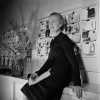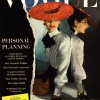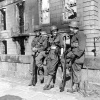1.  2.
2.  3.
3. 4.
4. 1. Eyes forward: Audrey Withers, the wartime editor of British Vogue, in 1944.
1. Eyes forward: Audrey Withers, the wartime editor of British Vogue, in 1944.
Norman Parkinson/Iconic Images
2. Inspecting the wreckage: an image in British Vogue by Cecil Beaton, published in September of 1941. Cecil Beaton/Vogue, via The Condé Nast Publications Ltd.
3. Pragmatic pages: the model Betty McLauchlen on the cover Vogue in April of 1943.
Horst P. Horst/Condé Nast, via Getty Images
4. The photographer Lee Miller, center, talks to soldiers during the liberation of Rennes, France, in August 1944. Credit...David E. Scherman/The LIFE Picture Collection, via Getty Images
Fashion Magazine Editors, Take a Page From Audrey Withers
During wartime London, she showed the way for British Vogue.
By Ruth LaFerla
June 18, 2020
A woman in an hourglass suit poses, back to the camera, against the ruins of a bombed-out church in London. A study in incongruity by Cecil Beaton, that image was all the more riveting since it appeared not in a newsreel or in one of London’s proliferating tabloids, but in the rarefied pages of British Vogue.
Audrey Withers, the editor who commissioned it, made an appearance herself in the magazine’s November 1941 issue. Tidy and imperturbable in a plaid over-shirt and pillbox hat, she is seen huddled with her staff in a the basement of the magazine’s makeshift headquarters on New Bond Street, putting the final touches on the issue against a backdrop of peeling walls and shattered glass. “Here is Vogue, in spite of it all,” she declares in the accompanying text.
Her words had the force of a rallying cry, the assertion of a woman who, from the day she took the magazine’s helm in 1940, at age 35, was bent on serving readers coverage of country houses and city brogues alongside plain talk about coping with food shortages and clothes rationing, spliced with harrowing glimpses of a nation and world under siege.
A self-effacing figure who climbed the masthead as a copy writer and administrator, Withers was by her own account an unlikely pick for the job. “I am very well aware,” she wrote in “Lifespan,” her 1994 autobiography, “that I would not have been an appropriate editor of Vogue at any other period of its history.”
Yet her voice seems freshly resonant (and has been cited on social media) in a time of pandemic, widespread unemployment and unrest. “It is an old right-wing trick to sit tight and say nothing (because that’s the best way of keeping things as they are),” she once all but scolded her American employers at Condé Nast, and moreover “to accuse the left wing of ‘being political’ because it is forced to be vocal in advocating anything new.”
Withers’s left-of-center politics and visceral response to events beyond the hermetic world of style is the subject of “Dressed for War,” a biography by Julie Summers. Published in February by the British division of Simon and Schuster and recently optioned for television, the book is an appreciation of an editor coolly grappling with challenges of a chaotic time.
In a heated political climate, compounded in publishing by advertising declines, slashed budgets, staff cuts, and an audience largely diverted to rival social-media platforms, Withers, these days, is being invoked — in spirit at least — as a role model for a new generation.
The British Vogue editor, who died at 96 in 2001, has found a kindred spirit in Edward Enninful, the current editor of British Vogue. A champion of inclusivity and social progress, Mr. Enninful in his July issue gives star billing on the magazine’s cover to three essential workers — a train conductor, a midwife and a supermarket clerk — and a gallery of others inside.
An Irving Penn series commissioned once by Withers similarly portrays men and women holding traditional blue-collar jobs: a chimney sweep, a cobbler, a fishmonger and what was then known as a rag-and-bone man, a sack slung over his shoulder.
“Here at Vogue we are, perhaps, not most famous for chronicling the minutiae of everyday life,” Mr. Enninful acknowledges in his editor’s letter, adding, “I can’t think of a more appropriate trio of women to represent the millions of people in the UK who, at the height of the pandemic, in the face of dangers large and small, put on their uniforms and work clothes and went to help people.”
His tribute arrives at a time of transition for fashion magazines. Harper’s Bazaar has announced that next month Samira Nasr, formerly the executive fashion director of Vanity Fair, will succeed Glenda Bailey, who stepped down as editor of Harper’s Bazaar in January. Ms. Nasr will be the first black editor of the venerable Hearst title.
“I will work to give all voices a platform to tell stories that would never had been told,” Ms. Nasr said in a video announcing her move.
Over at American Vogue. Anna Wintour, its editor in chief, and the artistic director of its parent company, Condé Nast, has faced calls for accountability on matters of race and class, amplified during an abrupt change of leadership at the food magazine Bon Appétit.
In a new memoir, “The Chiffon Trenches,” the former Vogue mainstay André Leon Talley portrays Ms. Wintour, his onetime friend and boss as soulless and stone-faced, driven by nothing more urgent, as he writes, than “a sense of her own ability to survive as a power broker,” carrying on “with sheer brute force.”
Long said to be approaching retirement, Ms. Wintour has cast herself as a progressive; she announced her support of Joe Biden, the Democratic presidential candidate, in Vogue’s May issue. A vocal champion of the fashion industry, if not of the consumer, in her June/July issue she introduced A Common Thread, a fund-raising initiative to support designers.
The magazine otherwise offers a somewhat tepid acknowledgment of the continuing coronavirus crisis, with uncaptioned portraits of masked health care workers and a portfolio of “creatives” — models, artist, designers and others — photographed chopping and cooking homegrown vegetables, painting, or bonding with their pets.
High time, some argue, for change of the guard. “The industry needs a new mind-set,” said Phillip Picardi, a former editor at Teen Vogue and Out magazine. The very concept of leadership needs reinvention, Mr. Picardi suggested. “When I think about the overall culture, how these insular people keep being built up or torn down,” he said, “it seems society is ready to move past the idea of one-above-all.”
For others the matter is moot. “To have an expectation that an editor is going to lead in the conversation, whether in words or pictures is to be disappointed,” said Ariel Foxman, a writer and brand consultant, and the former editor of InStyle. “To expect a magazine to become that voice or offer consistent and innovative context for the new world that we live in is anachronistic.”
At a time of rising democratization in media, authoritarian magazine editors may themselves be anachronisms. “The celebrity editor is a dead or dying breed,” said Samir Husni, the director of the Magazine Innovation Center at the University of Mississippi. In a time of upheaval, he said, readers are increasingly inclined to place their faith in a brand, not an editorial diva.
“The editor doesn’t have to be somebody sitting on the side of the runway,” said Michael J. Wolf, a media consultant and the chief executive of Activate, a consulting firm in New York. “I don’t think readers are looking for the editors themselves to be aspirational figures.”
They may gravitate instead to a model cast in the image of Withers, a woman driven less by self-regard and a thirst for fame than by a fervid sense of mission. “It is simply not modern to be unaware of or uninterested in what is going on all around you,” she wrote to Edna Woolman Chase, her mentor, in a kind of manifesto.
In a time of crisis, Withers argued, a fashion magazine would be remiss turning its back on politics. “One is being every whit as political,” she wrote to Woolman Chase, “in giving one’s tacit approval to things as they are than in pressing for change.” She buttressed that conviction, dispatching journalists including Beaton and Lee Miller, a model turned photographer, to the front lines.
Who would have thought? Born in 1905 into a free-spirited, intellectual family, Withers was educated at in Oxford and worked in a bookshop and, briefly, at a publishing house, before taking a post at Vogue.
“Austerity,” as she was affectionately known among staff, was bent from the outset on exhorting her readers to make more of less — and, at a time of shortages to plant and harvest their own vegetables, stock preserves and, rather than shop, to “mend and make do” with items already in their wardrobes.
Sartorially she lead by example, her own fashion rotation consisting of three suits and some blouses for work, one wool dress for evenings, and trousers and sweater off-duty. When limits were placed on the amount of labor and material used in civilian clothing, she consulted the British Board of Trade on a range of utility fashions priced within reach of many of her readers and encouraged paring down. “Subtraction,” she told readers, “is the first of fashion rules.”
She reacted with wit to London’s nightly blackouts, sprinkling her pages with luminescent hatpins and brooches and a selection of jaunty gas mask totes.
Amid fears that female factory workers would tangle their hair in machinery, she promoted cropped styles.
Most radically, she assigned Miller to write about and photograph the siege of Saint Malo in Brittany, the liberation of Paris and the death of Hitler. As Vogue’s war correspondent, Miller delivered, capturing scenes from a hospital in a bombed-out Normandy village, including a searing image of a dying man being treated by an emergency medical team. She documented the liberation of Buchenwald, with its piled skeletal bodies, though Withers chose to publish only a small photograph.
Withers commissioned the journalist Jane Stockwood to write about the depredations of Nazi occupation in France, the shortages of food, electricity and water, and most wrenchingly, the massacre at the village of Oradour-sur-Glane, where SS officers shot 190 men and burned 452 women and children alive in the church.
“It might not have been what Vogue readers wanted to read,” Ms. Summers writes, “but it was what Audrey needed them to understand, and she did not let up.
That kind of fierce commitment could go a long way toward restoring the vitality of fashion magazines. “When we divorce political and social justice coverage from a magazine’s fashion coverage, we are saying these things are separate,” Mr. Picardi said. “What I’ve learned is, they are not.”
source | nytimes

 .
.



